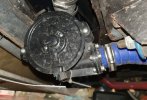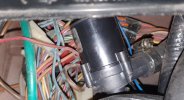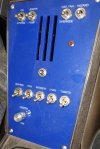I haven't thought this through really, so just throwing it out to everyone for curiosity sake. Could the electric pump (e.g. CWA or DC) be mounted somewhere up front, near the radiator, rather than in the engine bay? Mainly to reduce the clutter in the bay, but that would also improve the car's weight distribution some (the CWA pumps are a bit heavy). Jon, you might have already addressed this, sorry I don't recall.
I'm wondering...... if the pump could be located anywhere (relatively speaking), and a "block-off / adaptor plate" replaced the stock pump, then could the routing from the pump, T-stat, and said plate go completely away from the exhaust manifold? In other words a revamp of the overall routing of hoses and such? This would address the issue discussed about heat from the exhaust manifold and might allow more flexibility in locating components.
Jon, also interesting to read your comment on preferring the "400" over the "200". I'm curious to hear more about that, especially considering the CWA I was given for free happens to be a 400.




